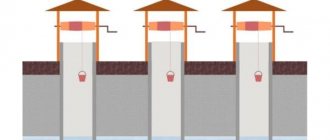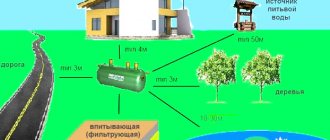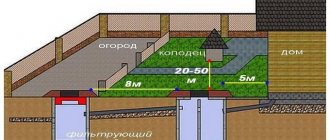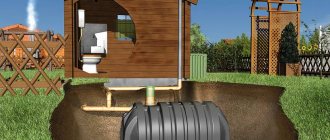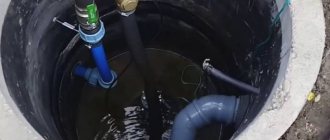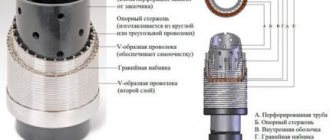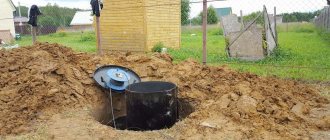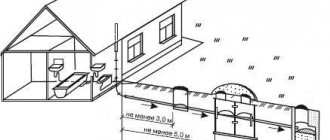Most owners of sites both within the city and outside it are faced with the issue of wastewater disposal during construction. A less labor-intensive and more effective solution is the use of local wastewater treatment plants (WTP). The distance from the septic tank to the well is an important aspect of the installation and the SNiP and SanPiN standard, on which the safety of residents depends. A septic tank, being an analogue of a cesspool, with significant savings allows you to maintain the environmental background at the required level under a number of conditions.
Near the well
What do you need to start from?
The exact distance from the septic tank is regulated by the Federal Service for Surveillance on Consumer Rights Protection and Human Welfare (Rospotrebnadzor). Refers to the federal executive authorities, specializing in control and supervision of the sphere of ensuring sanitary and epidemiological safety of the population of the Russian Federation.
At the stage of designing the location of the septic tank, it is necessary to adhere to a number of sanitary and epidemiological rules and regulations (SanPiN), as well as building codes and regulations (SNiP):
- SNiP 2.04.03-85 “Sewerage. External networks and structures" is the main document containing the essence of the topic raised.
- SNiP 2.04.01-85 “Internal water supply and sewerage of buildings” is a standard that includes standards for the distance of settling tanks from drinking water.
- SanPiN No. 2.1.5.980-00 “Hygienic requirements for the protection of surface waters” - a list of rules characterizing the boundary of the protection zone relative to the surface of reservoirs.
- SanPiN 2.2.1/2.1.1.1200-03 “Sanitary protection zones and sanitary classification of enterprises, structures, and other objects” - a document regulating the passage of sanitary zones around objects that pose a potential danger (which include septic tanks)
- SanPiN 42-128-4690-8 “Sanitary rules for the maintenance of territories of populated areas”, regulating the rules for arranging a septic tank.
These regulations list all current distances to objects located on the land plot and beyond. The conditions for their installation, operation and maintenance are described in detail.
How to influence regulations
It is possible to reduce the distance that is prescribed to be observed according to SNiP, especially in cramped conditions in small areas. You need to find an alternative to a septic tank.
Instead, you can put a sealed storage container, most often made of durable plastic. The size and shape of the storage tank is selected depending on the parameters of the installation site, the intensity of water consumption, and, accordingly, drainage and the number of people living. The container itself is inexpensive, but you will have to regularly pay for pumping out wastewater using vacuum cleaners.
It may be worth purchasing a biological aerobic or anaerobic station with a system for complete water purification using a special type of bacteria. The requirements for distances when installing such a station to objects are completely different, which allows it to be used in small areas. But the price of this type of septic tank is quite high, and it is also worth noting its inability to work autonomously, since electricity is required for its full operation.
Minimum padding
Existing regulations require strict compliance with the following territorial location rules:
- Distance from the source of drinking water – 20-50 m.
- The distance from the border with the neighboring property is 3 m.
- Location relative to a pond, lake, other body of water with stagnant water - 30 m. To the river - 10 m.
- Location near the house - at least 4 m.
- Distance from the road (regardless of the type of surface: asphalt, soil, concrete) – 5 m.
Distance of the septic tank from objects of various purposes Source aquasistem.ru
Obviously, the above standards regulate not only the location of the septic tank relative to the source of drinking water, but also the remoteness of other nearby objects: houses, roads, reservoirs, boundaries of the land plot.
Distance of the septic tank from other objects
Sanitary standards regulate the distance not only between the septic tank and the well. The distance from other objects is also strictly established. be located at least 5 meters from the roadway . If it is located closer, then constant vibrations from passing traffic may disrupt its seal. The same distance should be between the treatment plant and the home, as well as various pipelines. This object should not be placed too close to the house, not only because of possible unpleasant odors. This threatens the destruction of the foundation, which can occur due to increased soil moisture.
The distance between the septic tank and the neighboring fence is also a regulated value. It is 2 m. The placement of the treatment plant itself must be agreed upon with the neighbors.
Requirements for a septic tank
As mentioned earlier, the list of conditions that a cesspool must meet is listed in SanPiN 42-128-4690-8 and the previously unnamed SNiP 30-02-97. The contents of the documents provide for a number of requirements for the location and design of the septic tank. We will not study these regulations in full; we will only reveal their main essence:
- The settling tank must be located on an area that is entirely the property of the land user.
- The distance from it to the main water supply should not be less than 10 m. For lower values, you will receive SES approval.
- The depth of the cesspool should not exceed 3 m. However, here one more mandatory condition must be taken into account. It lies in the distance from the bottom of the septic tank to the top point of groundwater. Its minimum value is 1 m.
- A hermetically sealed window, door, and hatch are installed in the ground part of the drainage pit.
- Filling the sump higher than 35 cm from the top edge is not allowed.
- Pumping is carried out as it is filled, but not less than once every 6 months.
- When pumping out, disinfection must be carried out.
What should a cesspool be like? Source stroiteli124.ru
Alternative septic tank models
The use of concrete septic tanks or those made of corrosion-resistant metal is not excluded. Heavy concrete and metal containers are not squeezed out to the surface by groundwater, so they can be mounted without fixation on a concrete base.
Despite all the advantages of storage systems, the technology does not provide for aerobic or anaerobic wastewater treatment. Relatively small reservoirs fill up quickly. The cost-effectiveness of using storage systems is increased by installing high-capacity storage facilities or connecting additional containers.
To serve a family of 3-4 people using a dacha for relaxation on weekends, it is recommended to use a storage tank with a volume of 4-6 m3. If the house is used for permanent residence, installing a container with a capacity of up to 10 m3 is justified in all respects.
The range of storage septic tanks offers popular models Bars-N, FloTenk-EN, Triton-N, Baikal-N and a number of other products made to European standards. In the category of homemade septic tanks, structures made from standard concrete rings have proven themselves well.
Penalties
The contents of a septic tank pose a threat to human health and the environment. Unauthorized installation is prohibited by law and must be eliminated. To obtain permission, you will need to apply with a pre-approved project to the SES or Rospotrebnadzor.
You can get a positive answer only when the project is developed in such a way that it does not contradict existing regulations and a number of rules. After receiving permission to carry out the work, the owner of the site can begin installing a septic tank. It is not recommended to cheat and deviate from the contents of the developed scheme, since as a result of detection this will be reflected in a number of penalties.
In addition, it must be taken into account that an inspection commission may arrive at the site at any time. The purpose of her visit is to verify the actual and documentary distances of the septic tank. Based on the results of the activities carried out, a compliance report is drawn up, which will indicate the detected deviations (if any).
Any violation of the installation or operation of a septic tank may result in sanctions in the form of a fine or a ban on further use with forced dismantling of the structure. The penalty is determined based on the seriousness of the current situation and previously recorded cases of ignoring legal requirements.
Healthy! Violation of the above standards implies administrative liability in the amount: for legal entities - from 20,000 to 250,000 rubles, for individuals - from 1,500 to 20,000 rubles. In case of repeated violations or large-scale damage to the environment, criminal liability is permitted.
Drawing up an inspection report Source sovet-ingenera.com
The following situation can be cited as an example. The owner of a country house built a regular septic tank with a filter bottom. However, he did not take into account that such a design can be used if the volume of drained waste per day does not exceed one cubic meter. In his situation, the release is much greater, which is documented. Let's say this is done taking into account the readings of the cold/hot water meter.
In this situation, the owner of the house faces a fine, the amount of which is determined by the magistrate and will depend on the degree of violation of environmental standards.
Disagreements over the location of the septic tank Source www.ogorod.ru
If, as a result of a complaint received from neighbors, a one-time violation of the rules for using a septic tank is revealed, the violator will receive a warning in which it will be strongly recommended to eliminate the problem and resolve the issue peacefully.
Material and legal liability
A septic tank poses a threat to human health and the environment. Unauthorized installation of this structure is prohibited by law, and construction requires permission from the SES. To obtain it, you need to draw up a project and approve it. Permission can only be obtained if the project complies with all standards and regulations. It is worth remembering that after completion of the work, SES employees may visit you and make sure that the construction was done according to plan.
Violation of norms is subject to administrative liability. Legal entities will pay a fine from 20 to 250 thousand rubles, and individuals from 1.5 to 20 thousand rubles. If this is the first violation of sanitary standards, then you can get off with a warning. In case of large-scale consequences of the offense, criminal liability and a very real prison term are possible. In both cases, you will have to rebuild or remove the installed septic tank.
To avoid problems, carefully study the above SNiP and SanPiN. The peculiarities of the region should also be taken into account. Depending on climatic conditions and soil characteristics, requirements may vary.
Maintaining the distance from the septic tank and the communications leading to it to other objects or buildings on the site is an important stage in the design of future housing. Modern wastewater contains a large amount of chemicals that can poison the environment and people. Compliance with the standards will allow you to achieve comfortable living conditions and avoid negative consequences.
What else to pay attention to
When designing the location and design of a septic tank, it is necessary to pay attention to a number of conditions that will further facilitate its installation and simplify subsequent operation. The most significant are:
- If possible, based on the characteristics of the land, select a location for the septic tank where, even if it depressurizes, dirty water will not get into clean water (surface, groundwater).
- Acceptable values are determined individually and calculated depending on the type of soil. In this situation, the filtering properties of the latter play the main role. For example, wastewater that passes through clay is purified better than wastewater that percolates through sandy soils.
- The optimal choice would be to locate the septic tank below the level of the water intake structures, although this condition does not apply to all areas. At the same time, it is not recommended to equip it in a lowland due to the high probability of filling with melt and rainwater.
- We should not forget about the level of soil freezing and try to arrange a sump below this level. Although, with almost 1.5 m, corresponding to the Moscow region, this most likely will not be possible. To avoid a possible problem with sewer freezing, try to insulate the pipeline or extend the heating cable.
Schematic location of the septic tank on the site Source kanalizaciya1.ru
Healthy! If, as a result of repeated attempts, you have not been able to find the best place for the sump, contact a specialist.
Why is a septic tank dangerous?
A septic tank is associated with the following risks for humans and the site:
- flooding of buildings;
- contamination of the site with sewage due to overflow and untimely cleaning of the septic tank, or during floods;
- the main danger is the release of waste into the soil and aquifers, i.e. literally into your glass. How can this happen if the plastic tank is durable and airtight? There are several reasons for this. These are installation errors, errors when choosing a location for a septic tank on the site, as well as rupture of pipes and depressurization of joints. Alas, no one is immune from emergency situations - we can only reduce the severity of possible consequences, and this is possible if we find the most suitable place for a septic tank, away from wells, boreholes, and reservoirs.
Of course, ideally, it is better to choose a place for a septic tank at the stage of planning the entire site. Then it will be possible to arrange all buildings and communications in an ideal way. But more often you have to look for a suitable place when the house and barn are built and the site is landscaped. In this case, it is better to draw a site plan to scale, mark the house, all outbuildings, the fence, neighboring houses, trees, wells and boreholes. Then you need to arm yourself with a ruler and look for the optimal place so as not to violate any of the rules listed below. If independent research does not produce results, it is better to call for help from specialists who will additionally analyze the type of soil, the depth of groundwater and indicate the best location and depth for installing the septic tank.
Where to place a septic tank on 6 acres
The requirements specified in regulations are not always applicable in real life situations. For example, with the size of the minimum plot allowed to fall into the category of individual housing construction, 20 by 30 m, it is not possible to make such indentations. There are several ways to solve this problem:
- Pre-develop a building plan. In most cases, lack of distance occurs due to untimely planning. If at this stage you think through all the possible nuances and move the source of drinking water and the sump in different directions, you will be able to solve the problem.
- Increase the waterproofing properties of the soil. The easiest way is to add clay, which acts as an excellent natural filter. This can also be done in other available ways.
- Change the performance of the cesspool. In this situation, it is necessary to understand that if the volume of wastewater contained in the settling tank decreases, the requirements for compliance with sanitary and epidemiological standards are reduced.
- Integrate a biofilter into the sewage system. The device acts as an independent septic tank with an increased degree of purification. With it, the requirements for maintaining the distance from the septic tank to the source will be less. In addition, water can be discharged into a regular pit.
Depth of the septic tank Source pro100septik.ru
In fact, the construction of wells for the extraction of artesian water involves drilling a hole up to 50 m deep (it can also be deeper). In a high-quality design, water pumped from the bowels of the earth will never mix with what will be in the septic tank. Even if there is no more than 10 m between them.
However, artesian wells require maximum concentration of professionalism of the performers and regular preventive maintenance of the condition of the casing pipes. These conditions are not always met; as a result, there is a risk of food poisoning from products that get into drinking water from the upper layers (sewage, rain, contents of the sump).
The difference between an artesian well and a well Source septik-i.ru
Healthy! The difference between a well and a well is that the first supplies water from deep (50 or more meters) layers, the second - from the upper (no more than 25 m).
Distance from the house, septic tank, cesspool and neighbors’ fence
The footage from the well to the house does not have a clearly defined value. There are cases when the water source is located directly in the basement of a residential building. The only criteria in this matter are the ability to conveniently access the drilling machine site and not damage the foundation in the event of an accident.
The presence of various communications is taken into account, such as water supply, gas pipelines and electric cables. The mine should be located at least 30 meters from the low-pressure gas pipeline, and 100 m from the high-pressure gas pipeline.
Where to place the well on the site in relation to the septic tank
Depends on the type of soil on it. If the soil is normal, there should be at least 20 m between them.
In conditions of sandy, sandy loam or loamy soil, the source should be located 50-80 meters from the septic tank.
When placing a septic tank or pit on a site, they take into account such an indicator as the hydraulic connection of the aquifer where the well is located and the soil where wastewater can get.
If there is no hydraulic connection and wastewater does not flow directly into the aquifer, the gap can be as short as 20 meters. If the aquifer is not protected, it is increased to 50 meters.
Water quality can be affected by the proximity of a septic tank. It must be removed from the source by at least 30 meters.
Advice: the well should be located above the level of the cesspool to prevent wastewater from entering it, which can lead to contamination of drinking water.
It is also worth considering the question of what distance from the well the well should be located. Although it acts as a source, it can cause pollution due to its design.
